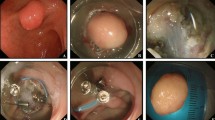Abstract
Background and aim
Endoscopic resection (ER) has been used to remove submucosal tumors (SMTs) in recent years; however, duodenal ER is associated with high rates of immediate or delayed bleeding and perforation. Whether ER can be recommended for the treatment of duodenal SMTs remains controversial. Therefore, we aimed to investigate the clinical outcomes associated with the ER of duodenal SMTs and to assess possible predictive factors for complications and incomplete resection.
Methods
This retrospective study included 141 patients with duodenal SMTs. The therapeutic outcomes from ER and procedure-related complications were analyzed.
Results
Of the 141 patients, 78.7% achieved complete resection and nine (6.4%) developed complications. The multivariate analysis suggested that location near the duodenal papilla (P = 0.010) and diameter exceeding 15 mm (P = 0.091) of duodenal SMTs were independent risk factors for complications in ER. Besides, submucosal fibrosis (P = 0.042), location near the duodenal papilla (P = 0.049), and irregular morphology (P = 0.067) were independent risk factors for incomplete resection.
Conclusions
ER can be recommended as an effective and minimally invasive treatment for duodenal SMTs.



Similar content being viewed by others
References
Li QL et al (2012) Submucosal tumors of the esophagogastric junction originating from the muscularis propria layer: a large study of endoscopic submucosal dissection (with video). Gastrointest Endosc 75(6):1153–1158
Shi Q et al (2011) Endoscopic submucosal dissection for treatment of esophageal submucosal tumors originating from the muscularis propria layer. Gastrointest Endosc 74(6):1194–1200
Li C et al (2022) Safety and efficacy of surgical and endoscopic resection in the treatment of duodenal subepithelial lesions. Surg Endosc 36(6):4145–4153
Wang L et al (2014) Gastritis cystica profunda recurrence after surgical resection: 2 year follow-up. World J Surg Oncol 12:133
Fukuhara S et al (2020) Management of perforation related to endoscopic submucosal dissection for superficial duodenal epithelial tumors. Gastrointest Endosc 91(5):1129–1137
Maruoka D et al (2013) Clinical outcomes of endoscopic resection for nonampullary duodenal high-grade dysplasia and intramucosal carcinoma. Endoscopy 45(2):138–141
Nonaka S et al (2015) Clinical outcome of endoscopic resection for nonampullary duodenal tumors. Endoscopy 47(2):129–135
Zhang YR et al (2022) Endoscopic submucosal dissection for proximal duodenal subepithelial lesions: a retrospective cohort study. Surg Endosc 36(9):6601–6608
Ye LP et al (2017) Safety of endoscopic resection for duodenal subepithelial lesions with wound closure using clips and an endoloop: an analysis of 68 cases. Surg Endosc 31(3):1070–1077
Tan Y et al (2019) Submucosal tunneling endoscopic resection for gastric submucosal tumors: a comparison between cardia and non-cardia location. J Gastrointest Surg 23(11):2129–2135
Wu QN et al (2017) Submucosal fibrosis in achalasia patients is a rare cause of aborted peroral endoscopic myotomy procedures. Endoscopy 49(8):736–744
Acknowledgements
This study was supported by the National Natural Science Foundation of China (Grant No. 82170555), Shanghai Academic/Technology Research Leader (Grant No. 22XD1422400), Shuguang Program of Shanghai Education Development Foundation and Shanghai Municipal Education Commission (Grant No. 2022SG06), and Shanghai “Rising Stars of Medical Talent” Youth Development Program (Grant No. 20224Z0005).
Author information
Authors and Affiliations
Contributions
P-HZ and Q-LL created the concept and designed the project. Z-HG, YZ, Y-FQ, and P-YF drafted the manuscript. W-FC revised the manuscript. All authors contributed substantially to all aspects of the article and revised versions.
Corresponding authors
Ethics declarations
Disclosures
Zi-Han Geng, Yan Zhu, Yi-Fan Qu, Pei-Yao Fu, Wei-Feng Chen, Ping-Hong Zhou, and Quan-Lin Li have no conflicts of interest or financial ties to disclose.
Additional information
Publisher's Note
Springer Nature remains neutral with regard to jurisdictional claims in published maps and institutional affiliations.
Supplementary Information
Below is the link to the electronic supplementary material.
Rights and permissions
Springer Nature or its licensor (e.g. a society or other partner) holds exclusive rights to this article under a publishing agreement with the author(s) or other rightsholder(s); author self-archiving of the accepted manuscript version of this article is solely governed by the terms of such publishing agreement and applicable law.
About this article
Cite this article
Geng, ZH., Zhu, Y., Qu, YF. et al. Risk factors for complications and incomplete resection after endoscopic resection for duodenal submucosal tumors. Surg Endosc 37, 9183–9189 (2023). https://doi.org/10.1007/s00464-023-10455-6
Received:
Accepted:
Published:
Issue Date:
DOI: https://doi.org/10.1007/s00464-023-10455-6




